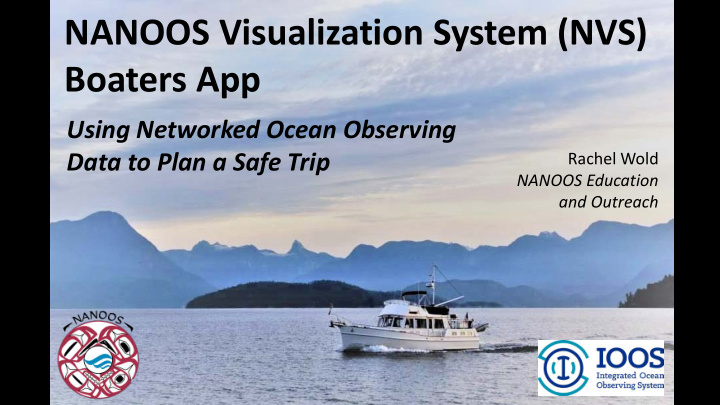



NANOOS Visualization System (NVS) Boaters App Using Networked Ocean Observing Data to Plan a Safe Trip Rachel Wold NANOOS Education and Outreach
Coastal IOOS: 17 Federal Agencies; 11 Regional Associations AOOS GLOS NANOOS NERACOOS CeNCOOS MARACOOS SECOORA SCCOOS GCOOS CariCOOS PacIOOS
Started by defining the region, the users, their needs: Coastal ocean: Northwest Northern extent of California Current Winds, topography, freshwater input, ENSO & other climate cycles Association of Major inland basins: Puget Sound-Georgia Basin, Columbia River Urban centers, nearshore development, climate variation Networked Coastal estuaries: Willapa Bay, Grays Harbor, Yaquina Bay, Coos Bay, +20 Ocean Resource extraction, development, climate Shorelines: Observing Rocky to sandy, dynamic: storms, erosion Winds, development,climate Major rivers: Systems Columbia River (~75% FW input to Pacific from US WC) many rivers (e.g., Fraser, Skagit) via Strait Juan de Fuca Dredging, water regulation, climatechange (NANOOS) NANOOS Region User Groups: Maritime: shipping, oil transport/spill remediation Fisheries: salmon, shellfish, crab, groundfish, aquaculture Environmental management: HABs, hypoxia Shoreline: erosion, inundation Hazards: Search and rescue, national security Educators: formal, informal, research Marine recreation: boating, surfing, diving
Boaters App features include: • NOAA nautical charts • Routing capabilities • Near-real time weather and sea conditions • Surface current, wind, wave and weather forecasts • Tide forecasts and water level plots • Marina information and a satellite image of the dock
Let’s plan a trip!
Scale 1:80,000
Scale 1:80,000
Continue up the Inside Passage
IOOS Regional Associations
Alaska Ocean Observing System (AOOS) www.aoos.org
And along the coast
Compare forecasts and current conditions
Th Than ank you ou! We’d love your feedback… please visit us at www.nanoos.org rwold@uw.edu
Recommend
More recommend